Post by Stalker6 on Jun 1, 2017 1:52:45 GMT
Revision July 2009 for scenario: DDAY - Op. Trident[/i][/u]
[/i][/b]
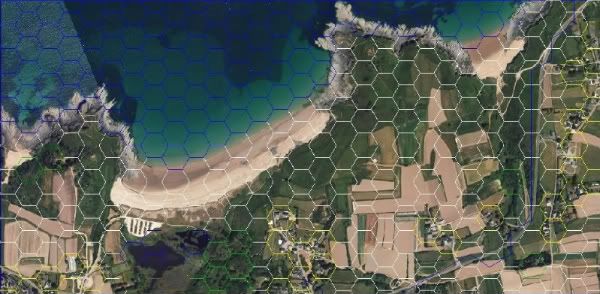
ARMY BUILDS
Allied Expeditionary Force – 1st Phase (291 pt):
USA – Landing forces (86 pt):
2x Higgins Boat
The Higgins Boat was used for many amphibious landings including Operation Overlord on D-Day, and previously Operation Torch in North Africa or the Allied invasion of Sicily.
3x M1 Garand
2x Untested Recruit
1x US Engineer
1x Thompson Gunner
2x Red Devil Cpt
1x BAR Gunner
3x Marine Riflemen
1x Marines Flamethrow
1x 37 mm Gun
1x Mortar M2
USA – Airborne forces (20 pt):
1x Screaming Eagle Cpt
1x Screaming Eagle Paras
USA – Air Force (34 pt):
1x P38 Lightning
The P-38 was the primary long-range fighter of USAF until the appearance of large numbers of P-51D Mustangs toward the end of the war. Called "fork-tailed devil" by the Luftwaffe, the role of the P-38 in the European theater was that of fighter-bomber during the invasion of Normandy and the Allied advance across France.
1x Mustang
Beginning in late February 1944, Mustangs began systematic strafing attacks on German airfields that picked up in frequency and intensity throughout the spring, with the objective of gaining air supremacy over the Normandy battlefield.
UK – Landing forces (47 pt):
1x Higgins Boat
1x Inspiring Lt
1x Royal Engineers
3x SMLE Rifle
1x Bren Machine Gunner
1x Sten SMG
1x Gurka Riflemen
UK – Airborne forces (8 pt):
1x Defiant Paratroopers
CAN – Landing forces (96 pt):
1x Amtrack
1x Eagled-Eyed NCO
2x Canadian Infantry
3x Sherman DD
The DD Sherman (Duplex Drive, but nicknamed Donald Duck) was used to equip ten tank battalions of British, Canadian and American forces for the D-Day landings.
*For enrichment of the scenario use WAS Ships as symbols for the special off-board “Bombardment” (see details below). The ships can’t be attacked or the Allied players stopped from using Shore and Inland Bombardment.
German Forces – 1st Phase (231 pt):
Coastal defense (164 pt):
3x Sandbagged MG
1x MG42
The MG42 entered service with the Wehrmacht in 1942 and was manufactured until the end of the war. It had a proven record of reliability, durability, simplicity, and ease of operation, but was most notable for being able to produce a stunning volume of suppressive fire.
1x 81 mm Mortar
6x Mauser Kar
1x Wehrmacht Oberlt
1x Luftwaffe Infantrymen
1x Panzerfaust
1x Wehrmacht Veteran Inf
3x Fortress Defender
1x Disciplined Spotter (allowed to move outside deployment area)
2x Light Mortar
1x Lel G18
1x BMW R75
1x 20 mm Flak
1x PAK 35/36 AT
1x Opel Blitz
2x Pillbox
Early in 1944, Field Marshal Erwin Rommel was assigned to improve the Atlantic Wall's defenses. He believed the existing coastal fortifications were entirely inadequate and he immediately began strengthening them. Under Rommel direction, a string of reinforced concrete pillboxes were built along the beaches, or sometimes slightly inland, to house machine guns, antitank guns, and light artillery. Minefields and antitank obstacles were planted on the beaches themselves, and underwater obstacles and mines were placed in waters just off shore. The intent was to destroy the Allied landing craft before they could unload.
2x Barbed Wire
4x Minefield
2x Tank Obstacle
Coastal defense - Reserves (31 pt):
1x Panzersp. P204
1x StuG III D
The StuG III assault gun was Germany's most produced armored fighting vehicle during World War II. Sturmgeschütz units held a very impressive record of tank kills – some 20,000 enemy tanks by the spring of 1944.
2x Mauser Kar
Coastal defense – Flak Battery (22 pt):
1x 88 mm Flak 36
1x Luftwaffe Infantry
Coastal Defense – Luftwaffe (14 pt):
1x Me 109
The Me109 was one of the first true modern fighters of the era, including such features as an all-metal monocoque construction, a closed canopy and retractable landing gear. The Bf 109 was produced in greater quantities than any other fighter aircraft in history, with a total of 33,984 units produced up to April 1945.
[/quote]
2nd Phase of the Scenario[/i][/b]
ARMY BUILDS
Allied Expeditionary Force – 2nd Phase (389 pt):
USA (247 pt):
1x Jeep
2x CCKV 352
1x M4A1 Sherman Commander
3x M4A1 Sherman
The M4 and M4A1 were the main types in US units until late 1944, when the preferred M4A3 with its more powerful 500 hp engine began replacing them, though M4s and M4A1s continued in US service for the rest of the war.
1x M5 Halftrack
1x M8 Greyhound
1x M10
1x M3 Light Tank
Most US tank battalions had three companies of M4 Shermans and one company of M3s or M5/M5A1s.
1x Buffalo Soldiers
1x Resourceful Hero
2x Rangers
3x M1 Garand Rifle
1x Untested Recruit
1x Red Devil Cpt
1x M1919 MG
1x M1 81mm Mortar
1x M8 75 mm Howitzer
1x 3” Gun M5
UK (125 pt):
1x Universal Carrier
1x Churchill Crocodile
The Crocodile was introduced as one of the specialized armored vehicles known as one of "Hobart's Funnies". It was produced from October 1943, just in time for the Normandy invasion.
1x Cromwell IV
Cromwell type IV was the most numerous variant with over 1,935 units produced. It first saw action in June 1944 during Operation Overlord, the Allied invasion of Normandy.
1x Inspiring Hero
1x Wickers MG
1x PIAT Gunner
2x SMLE Rifle
1x Inspiring Lt
1x 6 Pounder AT Gun
1x Spitfire
After the Battle of Britain, the Spitfire became the backbone of RAF Fighter Command and saw action in the European Theatre, Pacific Theatre and the South-East Asian theatre. Much loved by its pilots, the Spitfire saw service in several roles and was built in many different variants.
CAN (14 pt):
1x Jeep
1x Intrepid Hero
1x Canadian Infantry
FRA (3 pt):
1x Free French Infantrymen
German Forces – 2nd Phase (389 pt):
SS Panzer Division (389 pt):
1x Tiger I
1x SS Panther ausf G
By June 1944, Panthers were about half of the German tank strength both in the east and the west.
1x Panzer IV ausf H Commander
1x SS Panzer IV ausf F2
Most of the Panzer Divisions that saw action in Normandy initially contained an armored regiment of one battalion of Panzer IVs and another of Panthers, although Waffen-SS Panzer Divisions were generally larger and better-equipped than their Heer counterparts.
1x Panzer IV ausf E
1x Marder III ausf M
The various Marder IIIs fought on all fronts of the war. Even in February 1945 some 350 Ausf M were still in service.
1x Puma
1x Wirbelwind
1x Sdkfz 250
The Sd.Kfz. 250, very similar in appearance to the larger Sd.Kfz. 251, was a light armored personnel carrier for reconnaissance units, carrying scout sections. This basic variant usually mounted one or two MG34 machineguns.
1x Sdkfz 251
2x 20 mm Flak 38
2x SS Stormtroopers
2x SS Panzergrenadier
1x SS Haupsturmfuhrer
1x Grizzled Veteran
1x Wehrmacht Veteran Infantry
1x Panzershreck
1x Goliath
Although a total of 7,564 Goliaths were produced, the single-use weapon was not considered a success due to the high unit cost, low speed, poor ground, vulnerable command cables and thin armor which failed to protect the remote bomb. A few Goliaths were also seen on the beaches of Normandy during D-Day.
2x Mauser Kar
2x MG 42
1x 81 mm Mortar
1x Nebelwerfer
Nebelwerfers participated in every campaign of the German Army during World War II with the exception of the Balkan Campaign.
1x PAK 40 AT Gun
1x Opel Blitz
[/quote]
How to get the Map Pack?
The map pack for this scenario is available for anyone, for more information about acquiring it PM me.
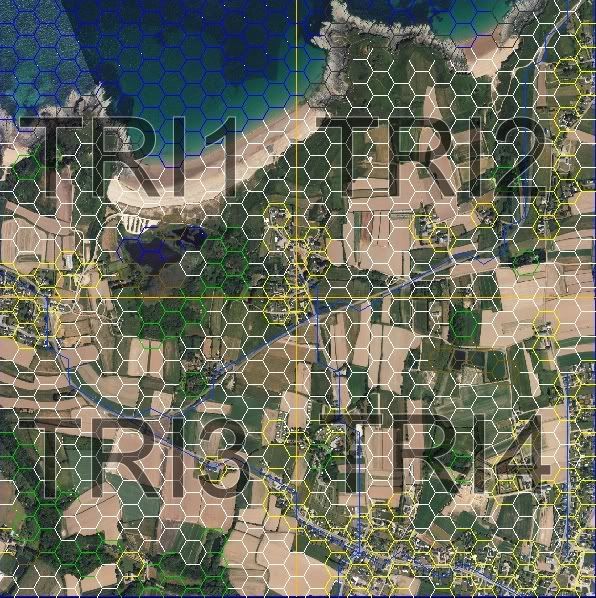
The Soundtrack for the scenario:
<embed src="http://www.youtube.com/v/IrJAwCBbnuc&hl=en&fs=1&" type="application/x-shockwave-flash" allowscriptaccess="always" allowfullscreen="true" width="320" height="265"></embed>
To wrap this up, I specify that new input for perfecting this scenario is always welcomed (as it has been until now also), please do PM me for any info regarding my Custom map(s).
Last, some pictures from one of test games for Op. Trident (for now only 1st Phase of the scenario in pictures, soon to follow pictures from second phase also).
Regards,
-----------------------------
My tribute to DDAY!

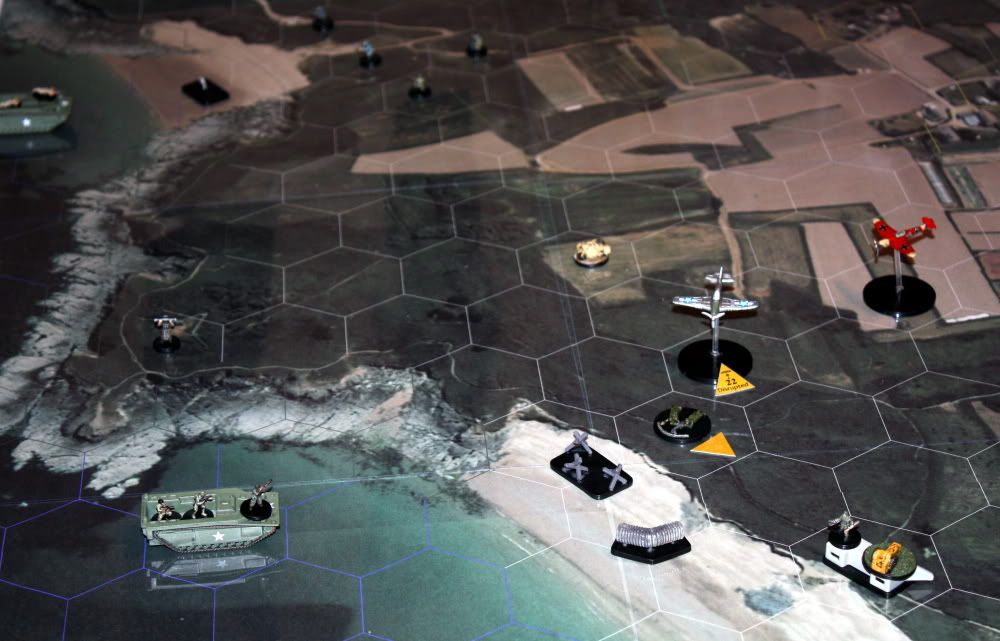
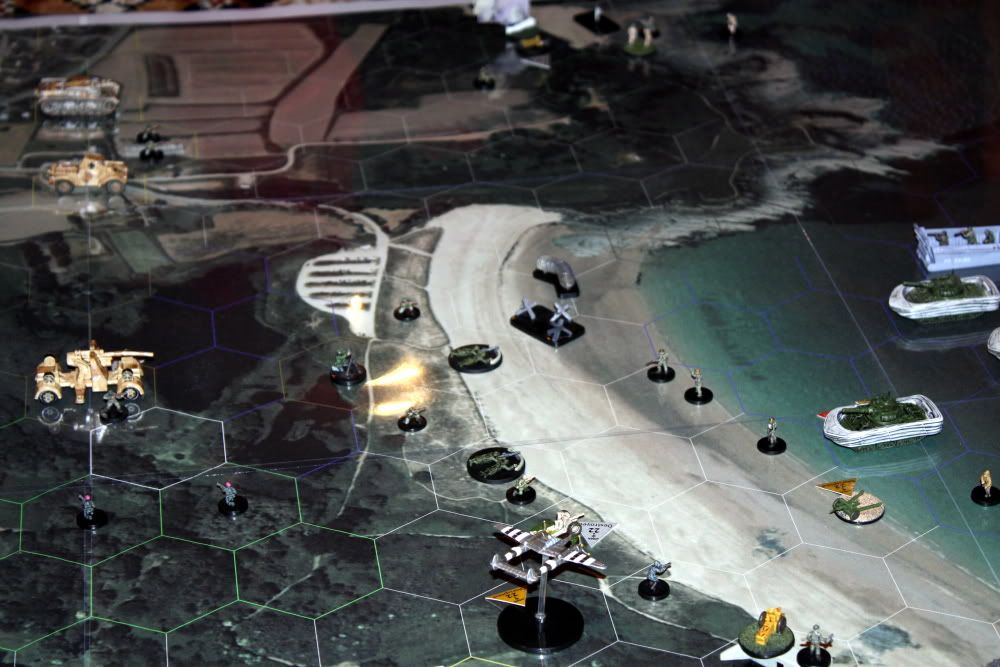

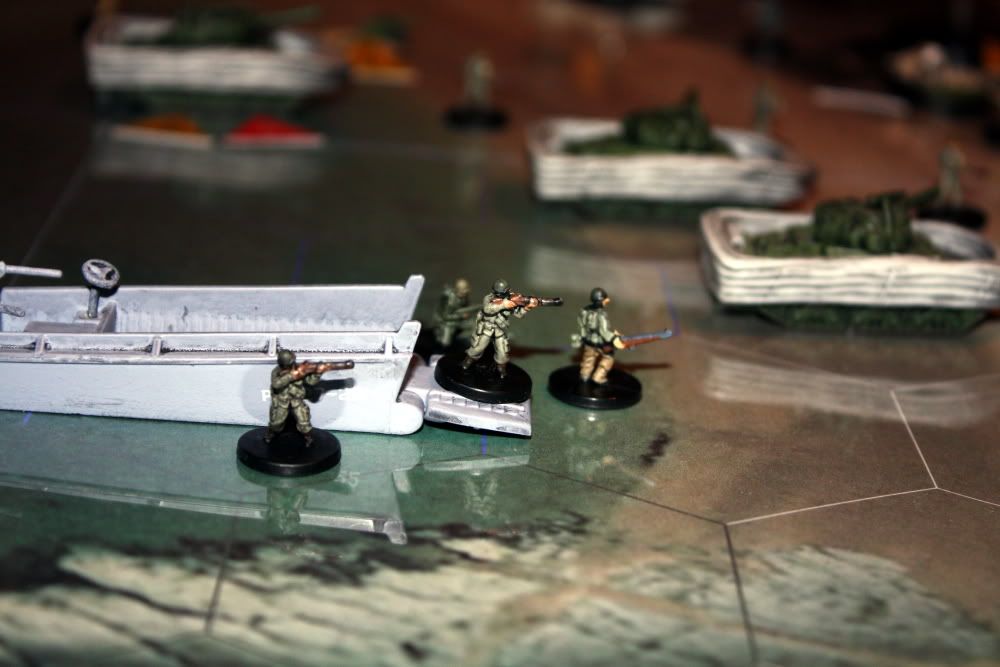
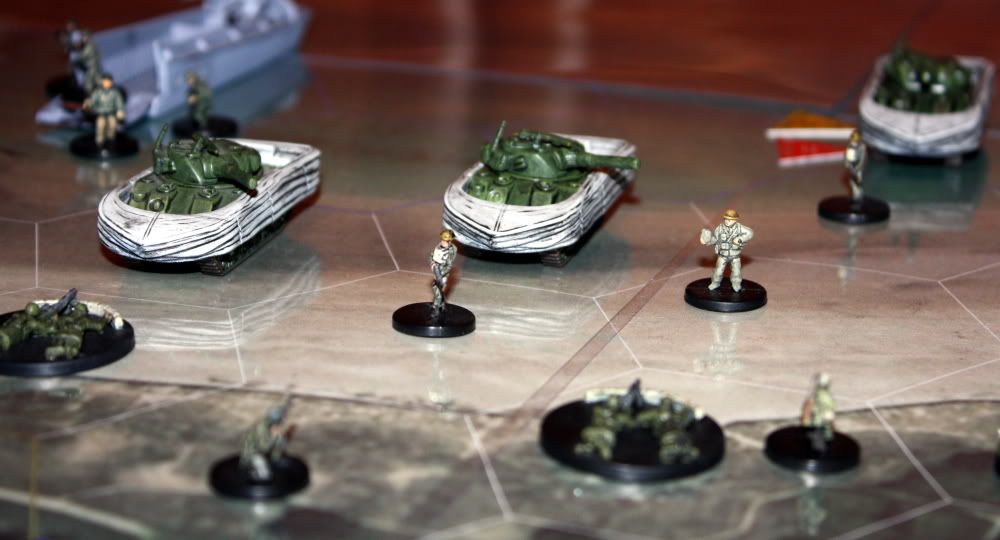
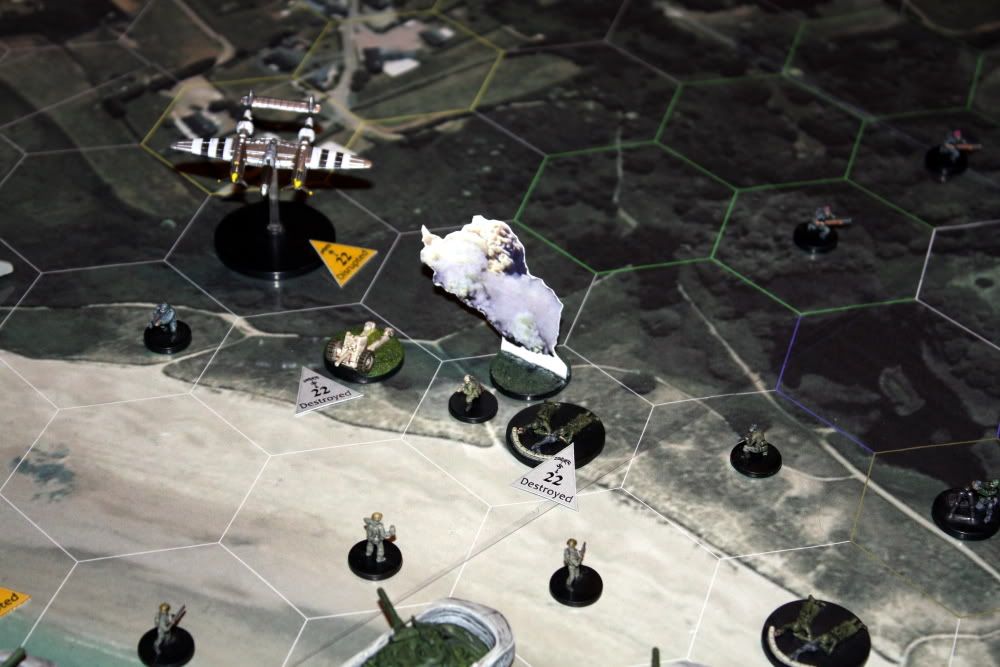

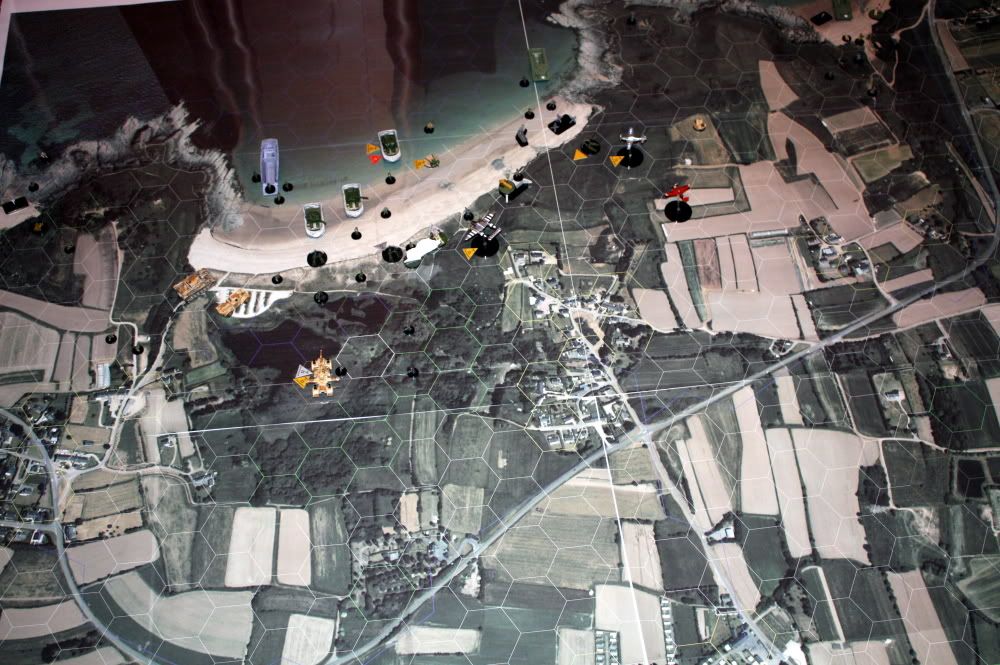
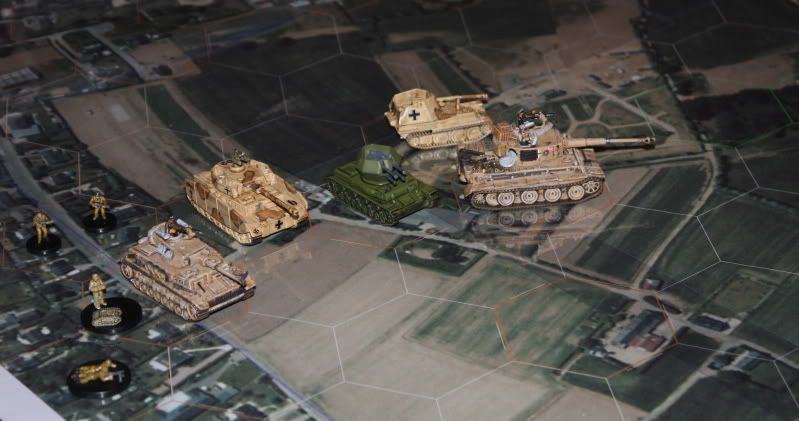

The second diorama, taken from a nice little game I called "Red Baron comes to Britain".
Allied Objective was to stop the Germans launch the Red Baron. I will skip the scenario details. This was a scenario based game, but no fixed builds. Restrictions were put in place for the Germans who weren't allowed to use more than 3 vehicles, they had to deploy as much as possible all Vengeance weapons / experimental. So the Do335 A0 was deployed, the Goliath Infantry and a few others.

The map that you see in the pics is the France 1944 DDAY (Op. Trident) Map Pack, but rotated (all maps deployed) - see above picture. AAM minis, except the planes, terrain and buildings.
Long story short, here it is:
Overview N-S

Overview German Beach defenses, US Paratroopers deploy:
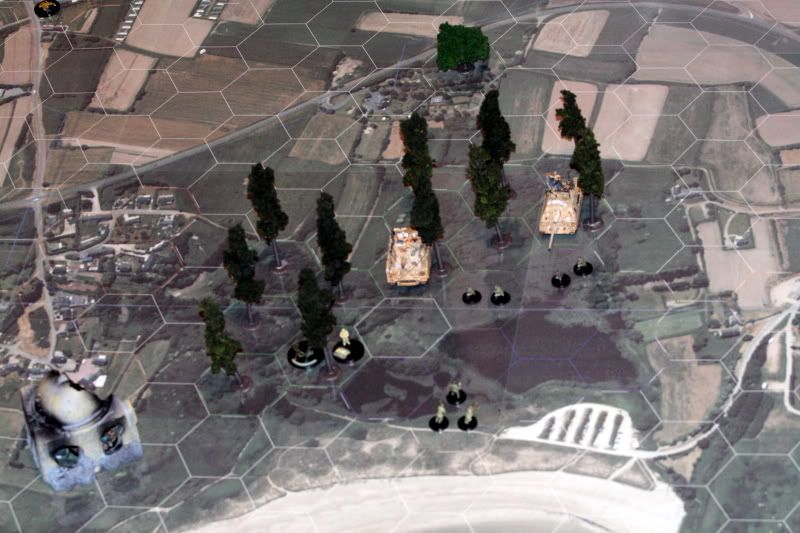
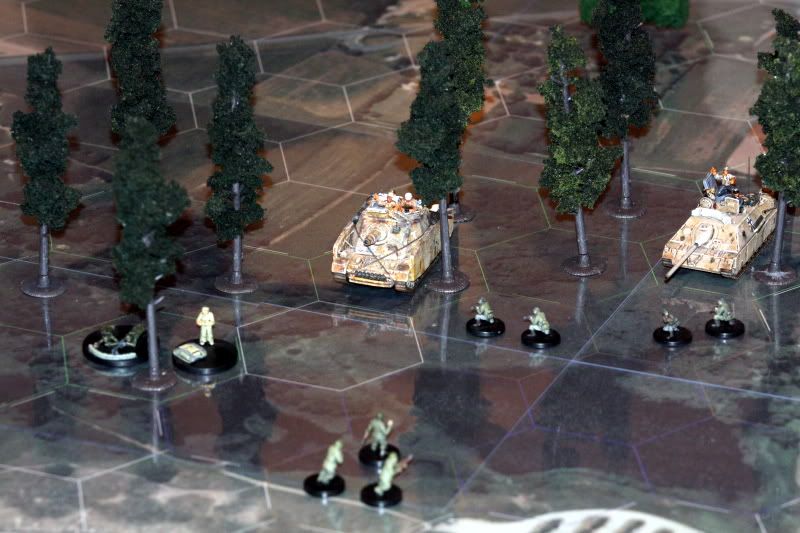
US landings begin, Me110 attack a Higgins Boat, DD Shermans:
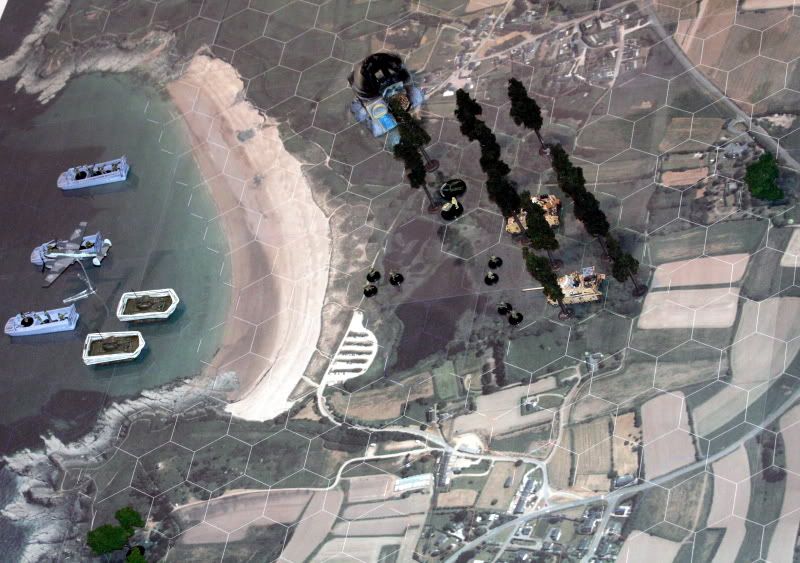
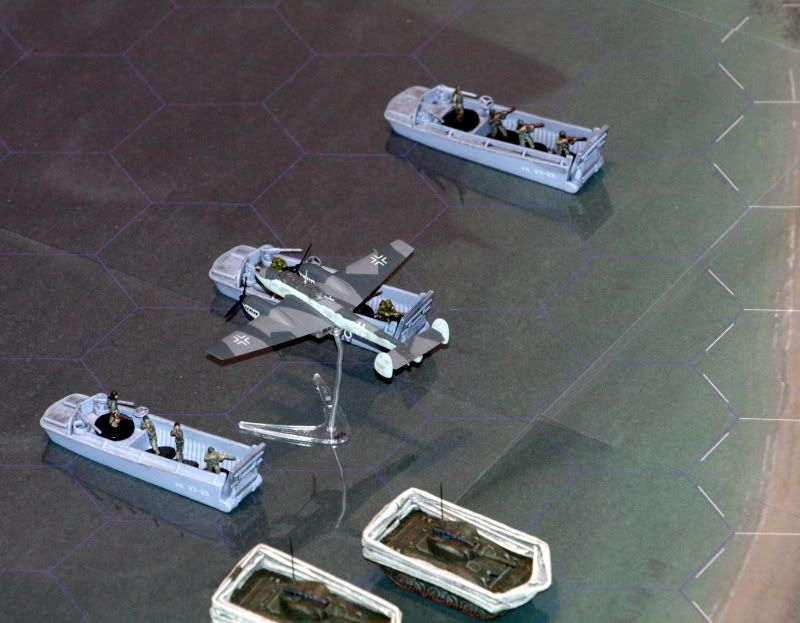

SS Division guarding the Red Baron, hidden in the evergreen forest:


While landings take place, US Air Force blasts 88 Flak (Thunderbolt), but with strange aircraft chasing their planes (Do335):
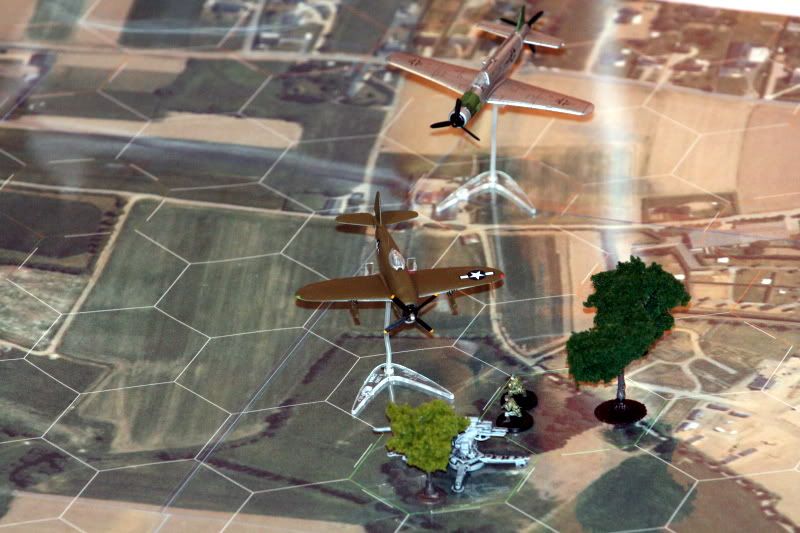
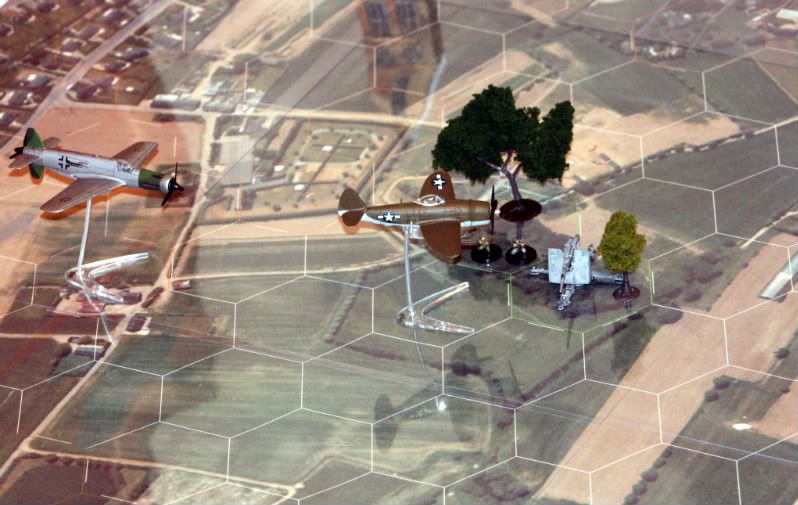
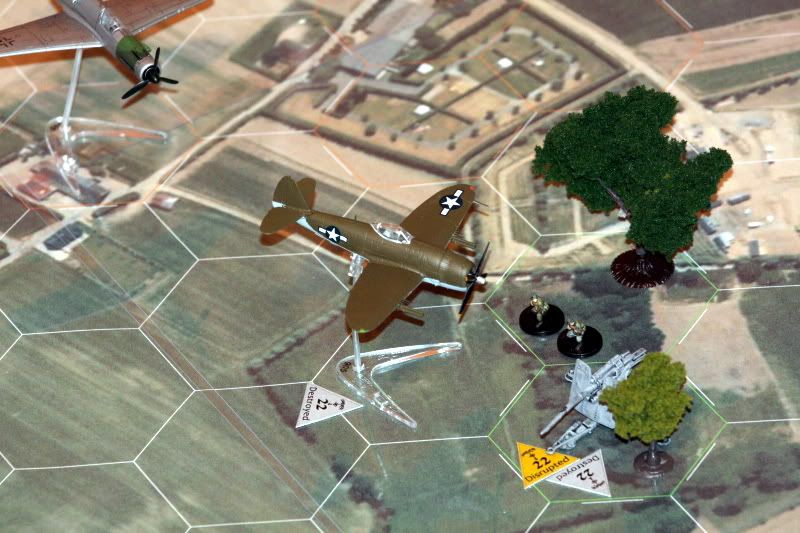
Lightning strafes some infantry while a FW190 Dora shoots it down:

Near the landing beaches, PAK 40 is hidden in a damaged building:

US forces break through, the battle moves towards inland:

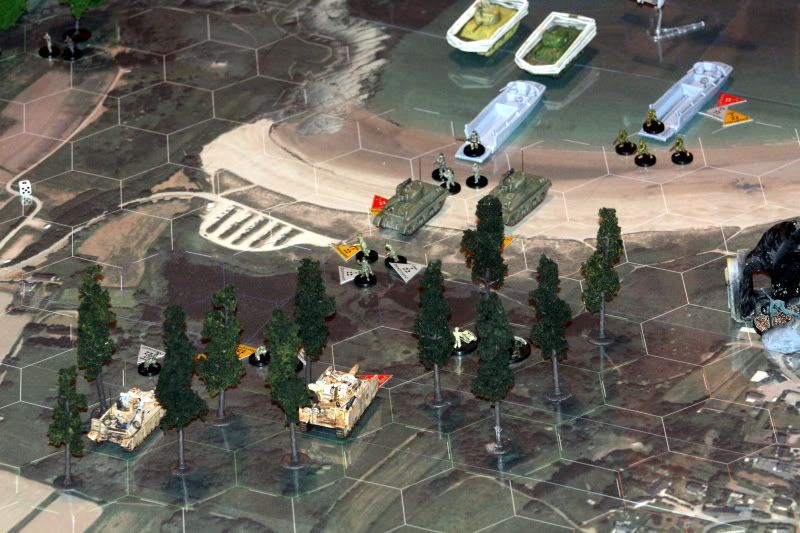
Once the Allies secured the beaches, heavy tanks appear (Pershing) while Stukas pick up some "leftovers":


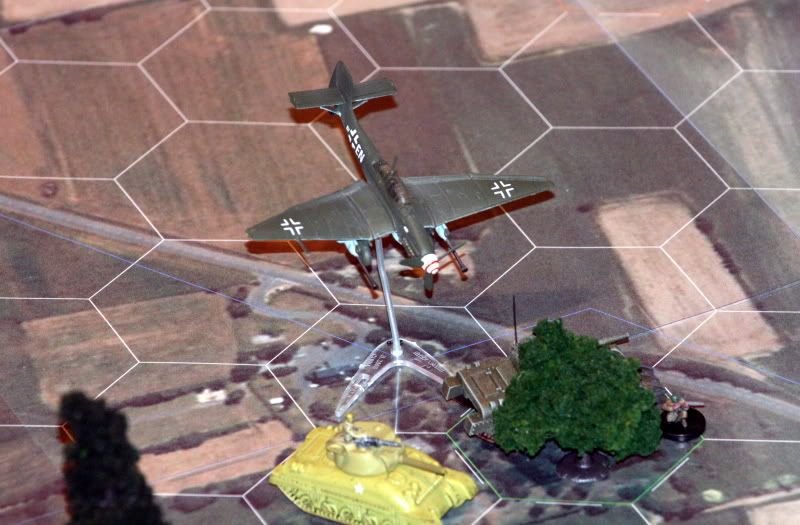
Battles rage all over, Allies gain advantage and are close to achieve their secondary objective:
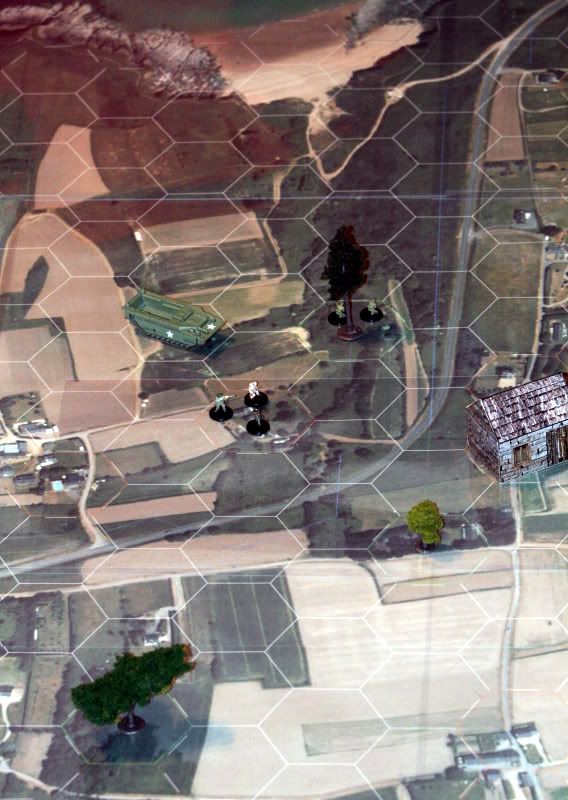
The Do335 survives the initial encounter with the Thunderbolt and gets another challenge from a Corsair:


Distracted by all the various german forces, the Allies fail to destroy the SS Division and Red Baron is launched over the channel, here a pic while leaving the french coast:

Some more pics with this map pack received from Gen. Hoth.
Please note that all maps of the map pack are deployed!
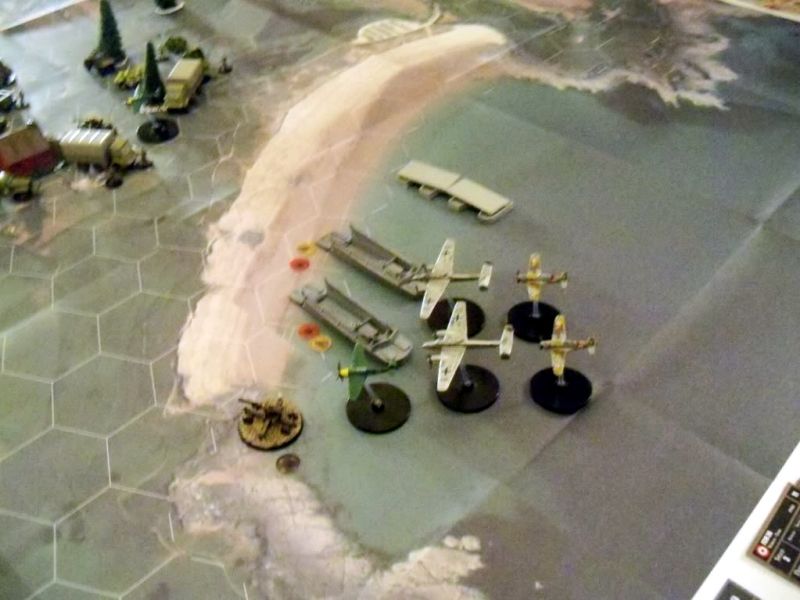

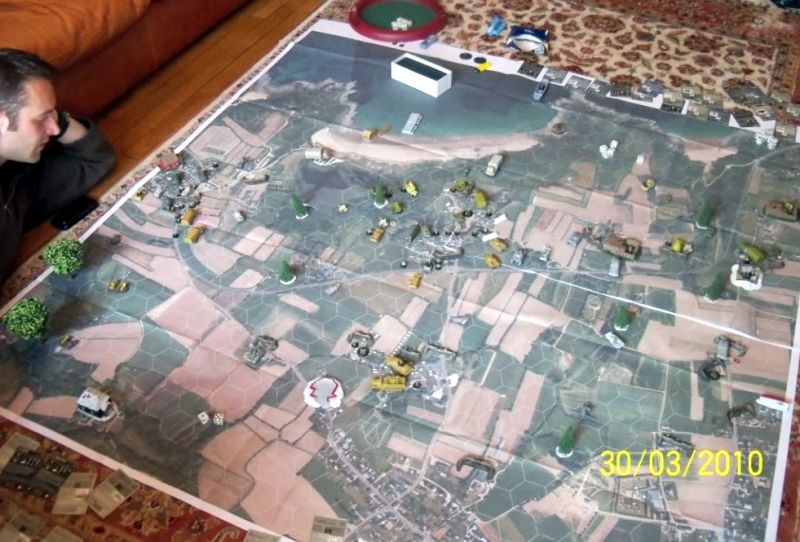
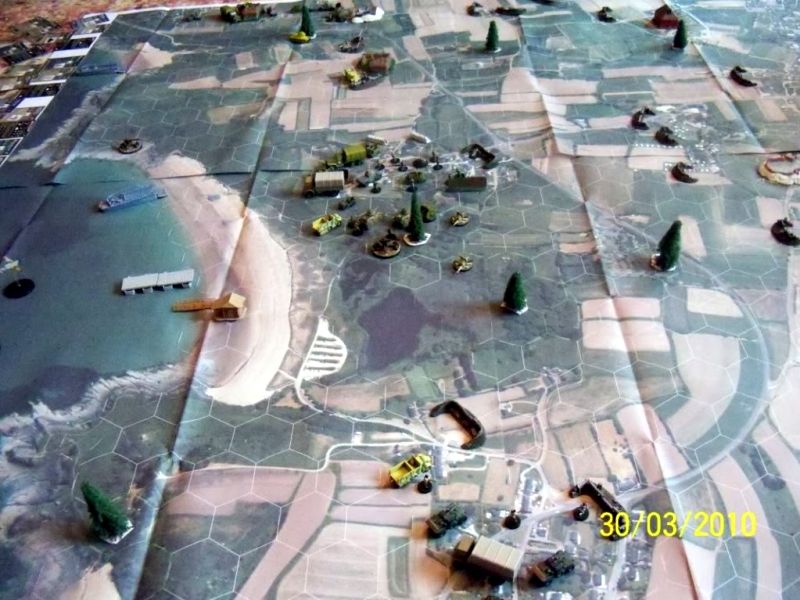
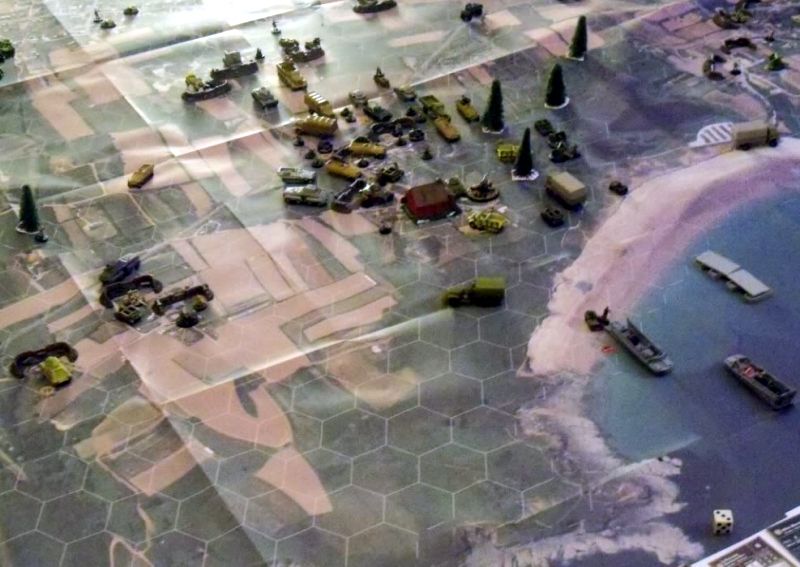
Pics courtesy of Snippersly - custom game with this map pack:
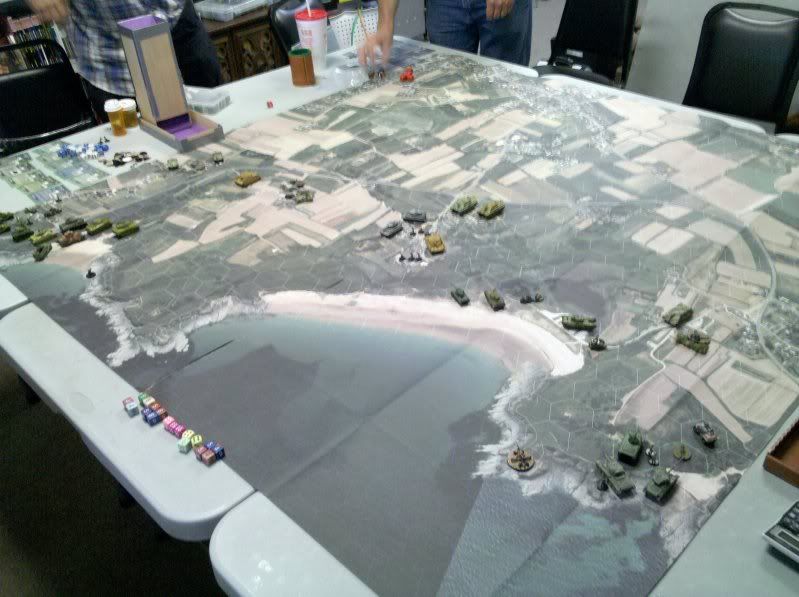
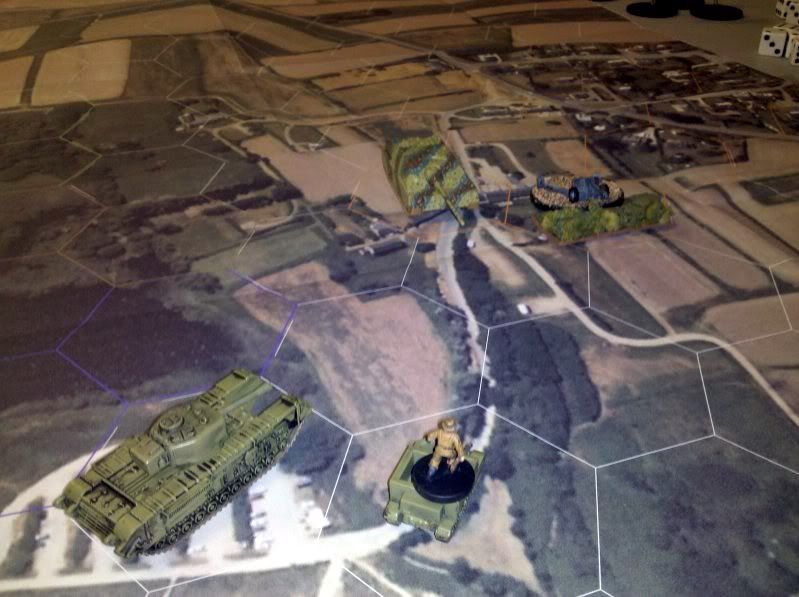



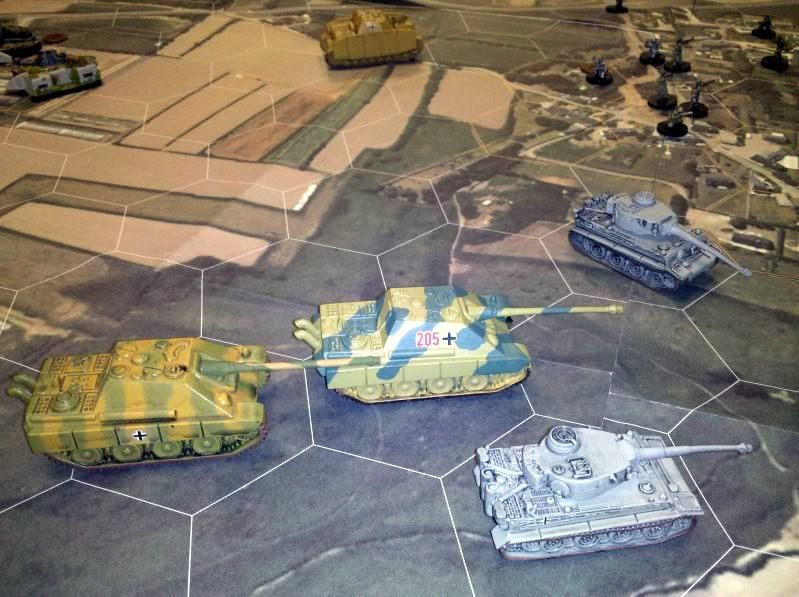
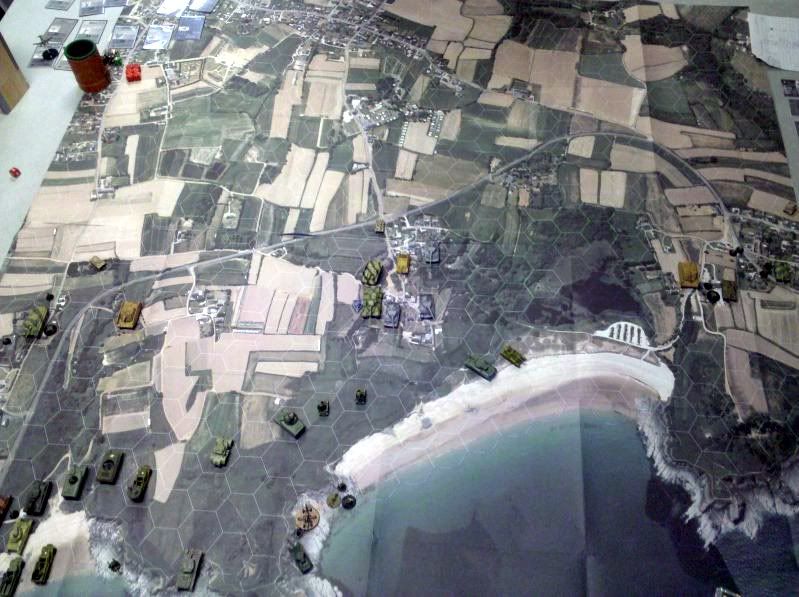
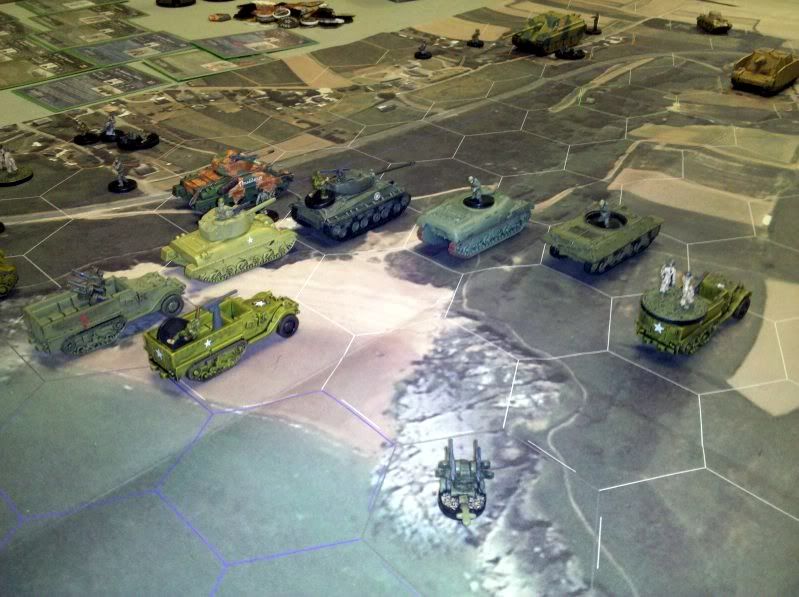

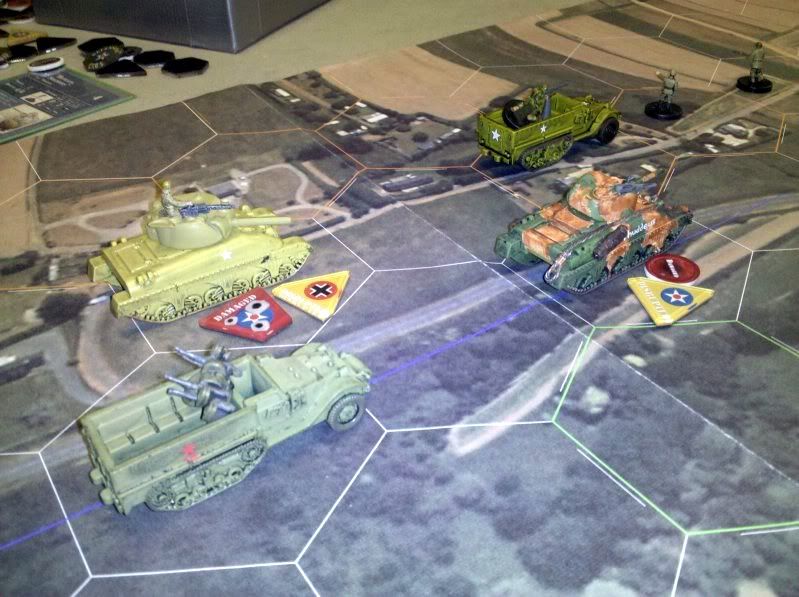
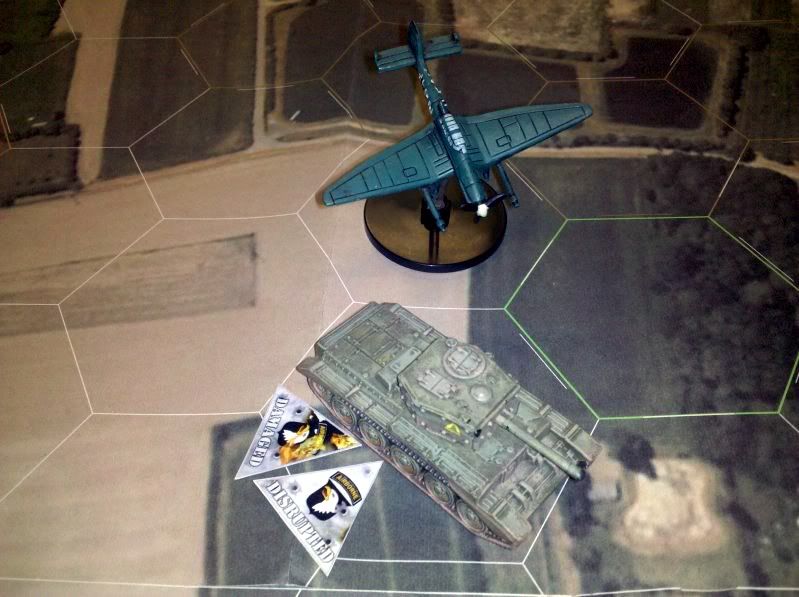
Introduction:
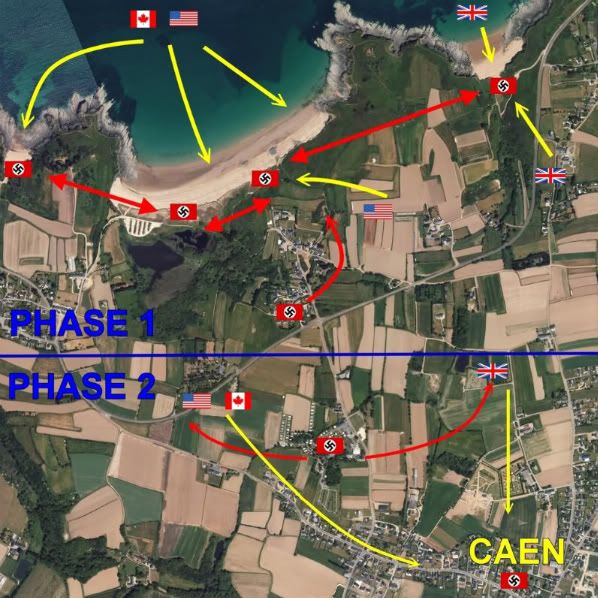
6th of June 1944, the Allied sea-invasion of Occupied Europe begins.
Operation Trident will see the combined effort of American, Canadian and British forces in order to secure a beach head into Normandy. After careful planning, the Allied Command is able to deceive the Germans who do not expect the invasion in this part of Occupied France.
The Atlantic Wall is not the formidable defense that the German High Command wants it to be, but it can serve as a major obstacle if used properly.
The Allied “effort” is concentrated on 3 beaches called 1-2-3 in the First Phase of the plan. German Coastal Defenses there are composed mainly by static forces and somewhat inexperienced. The Allied strategy is to wipe-out the German Coastal Defenses in order to secure a big enough beach head in order to land afterwards more troops. Sea and Air superiority is to be of help for the Allied invasion.
German forces guarding the beaches are highly immobile but rely on some heavy artillery that is positioned behind the “Wall” and a few Reserve units assembled in the nearby villages. To counter these, the Allies will launch an airborne assault just before the landings, assault that should prevent the enemy to inflict too much damage.
The Second Phase of the Allied plan will start once the beaches are cleared and the landing of new troops begins. The Objective is the capture of the town of Caen, a difficult task since the town is guarded by a SS Panzer Division.
From the first moments of the invasion, it is expected that the SS Division will move partially or totally from Caen towards the Atlantic wall in order to counter and even push back into sea the Allied invaders, while the Axis Coastal Units will try to hold on and inflict as much damage as possible.

6th of June 1944, the Allied sea-invasion of Occupied Europe begins.
Operation Trident will see the combined effort of American, Canadian and British forces in order to secure a beach head into Normandy. After careful planning, the Allied Command is able to deceive the Germans who do not expect the invasion in this part of Occupied France.
The Atlantic Wall is not the formidable defense that the German High Command wants it to be, but it can serve as a major obstacle if used properly.
The Allied “effort” is concentrated on 3 beaches called 1-2-3 in the First Phase of the plan. German Coastal Defenses there are composed mainly by static forces and somewhat inexperienced. The Allied strategy is to wipe-out the German Coastal Defenses in order to secure a big enough beach head in order to land afterwards more troops. Sea and Air superiority is to be of help for the Allied invasion.
German forces guarding the beaches are highly immobile but rely on some heavy artillery that is positioned behind the “Wall” and a few Reserve units assembled in the nearby villages. To counter these, the Allies will launch an airborne assault just before the landings, assault that should prevent the enemy to inflict too much damage.
The Second Phase of the Allied plan will start once the beaches are cleared and the landing of new troops begins. The Objective is the capture of the town of Caen, a difficult task since the town is guarded by a SS Panzer Division.
From the first moments of the invasion, it is expected that the SS Division will move partially or totally from Caen towards the Atlantic wall in order to counter and even push back into sea the Allied invaders, while the Axis Coastal Units will try to hold on and inflict as much damage as possible.
1st Phase of the Scenario

ARMY BUILDS
Allied Expeditionary Force – 1st Phase (291 pt):
USA – Landing forces (86 pt):
2x Higgins Boat
The Higgins Boat was used for many amphibious landings including Operation Overlord on D-Day, and previously Operation Torch in North Africa or the Allied invasion of Sicily.
3x M1 Garand
2x Untested Recruit
1x US Engineer
1x Thompson Gunner
2x Red Devil Cpt
1x BAR Gunner
3x Marine Riflemen
1x Marines Flamethrow
1x 37 mm Gun
1x Mortar M2
USA – Airborne forces (20 pt):
1x Screaming Eagle Cpt
1x Screaming Eagle Paras
USA – Air Force (34 pt):
1x P38 Lightning
The P-38 was the primary long-range fighter of USAF until the appearance of large numbers of P-51D Mustangs toward the end of the war. Called "fork-tailed devil" by the Luftwaffe, the role of the P-38 in the European theater was that of fighter-bomber during the invasion of Normandy and the Allied advance across France.
1x Mustang
Beginning in late February 1944, Mustangs began systematic strafing attacks on German airfields that picked up in frequency and intensity throughout the spring, with the objective of gaining air supremacy over the Normandy battlefield.
UK – Landing forces (47 pt):
1x Higgins Boat
1x Inspiring Lt
1x Royal Engineers
3x SMLE Rifle
1x Bren Machine Gunner
1x Sten SMG
1x Gurka Riflemen
UK – Airborne forces (8 pt):
1x Defiant Paratroopers
CAN – Landing forces (96 pt):
1x Amtrack
1x Eagled-Eyed NCO
2x Canadian Infantry
3x Sherman DD
The DD Sherman (Duplex Drive, but nicknamed Donald Duck) was used to equip ten tank battalions of British, Canadian and American forces for the D-Day landings.
*For enrichment of the scenario use WAS Ships as symbols for the special off-board “Bombardment” (see details below). The ships can’t be attacked or the Allied players stopped from using Shore and Inland Bombardment.
German Forces – 1st Phase (231 pt):
Coastal defense (164 pt):
3x Sandbagged MG
1x MG42
The MG42 entered service with the Wehrmacht in 1942 and was manufactured until the end of the war. It had a proven record of reliability, durability, simplicity, and ease of operation, but was most notable for being able to produce a stunning volume of suppressive fire.
1x 81 mm Mortar
6x Mauser Kar
1x Wehrmacht Oberlt
1x Luftwaffe Infantrymen
1x Panzerfaust
1x Wehrmacht Veteran Inf
3x Fortress Defender
1x Disciplined Spotter (allowed to move outside deployment area)
2x Light Mortar
1x Lel G18
1x BMW R75
1x 20 mm Flak
1x PAK 35/36 AT
1x Opel Blitz
2x Pillbox
Early in 1944, Field Marshal Erwin Rommel was assigned to improve the Atlantic Wall's defenses. He believed the existing coastal fortifications were entirely inadequate and he immediately began strengthening them. Under Rommel direction, a string of reinforced concrete pillboxes were built along the beaches, or sometimes slightly inland, to house machine guns, antitank guns, and light artillery. Minefields and antitank obstacles were planted on the beaches themselves, and underwater obstacles and mines were placed in waters just off shore. The intent was to destroy the Allied landing craft before they could unload.
2x Barbed Wire
4x Minefield
2x Tank Obstacle
Coastal defense - Reserves (31 pt):
1x Panzersp. P204
1x StuG III D
The StuG III assault gun was Germany's most produced armored fighting vehicle during World War II. Sturmgeschütz units held a very impressive record of tank kills – some 20,000 enemy tanks by the spring of 1944.
2x Mauser Kar
Coastal defense – Flak Battery (22 pt):
1x 88 mm Flak 36
1x Luftwaffe Infantry
Coastal Defense – Luftwaffe (14 pt):
1x Me 109
The Me109 was one of the first true modern fighters of the era, including such features as an all-metal monocoque construction, a closed canopy and retractable landing gear. The Bf 109 was produced in greater quantities than any other fighter aircraft in history, with a total of 33,984 units produced up to April 1945.
[/quote]
Deployment:

Axis Player(s) must deploy first all its units in the established deployment zones, as described below.
- Coastal defense units can’t move outside their deployment area (see map) until one of the beaches is lost to the enemy (cleared by the enemy). Obstacles can be deployed anywhere on the map (land hexes only). Pillboxes must be deployed inside the Coastal defense deployment area.
- Reserve units must be placed behind the Coastal Defense deployment area in any city hex (yellow hex) and are allowed to move only from 3rd Turn. These units can activate prior to 3rd turn if attacked by the enemy.
- Flak Battery units will be placed behind the Coastal Defense deployment area in any marsh hex (brown hex).
- SS Panzer Division: will deploy in its deployment area (see map – 2nd phase of the scenario) and can’t move until the movement phase of turn 4.
Allied Player(s) will deploy second, after the Axis player, as described below:
- First Allied units to deploy are the Soldier-Paratrooper subtypes in the 1st Turn.
Aircraft can be deployed in any turn (optional: use the Weather House Rule starting with the 3rd turn, for “enhanced” fun/realism – the Player that wins Initiative rolls a die, if it turns out an “1” you get “bad weather” and any airborne units can’t be deployed).
The rest of the units will deploy starting from the 2nd turn.
“Naval Shore Bombardment” can be used once per game, only in the First Turn.
- From the Second Turn of the game, the Allied player will deploy the rest of the units in the established deployment zones (1-2-3). The player can choose which units to land in the first wave of attack on the beaches (except Untested Recruits which can’t be landed in the first wave), but he must try to land at list once on all three beaches until the beginning of turn 4 (see deployment map key points 1-2-3). The various Allied nations can be mixed.
After all Axis coastal defense units are destroyed on at least one beach (one beach cleared), the Allied player may use once per game “Naval Inland Bombardment”. Also, after the Costal defense is annihilated on at least one beach, new Allied units can be deployed directly to the beach hexes as described in the Second Phase of the Scenario.

Axis Player(s) must deploy first all its units in the established deployment zones, as described below.
- Coastal defense units can’t move outside their deployment area (see map) until one of the beaches is lost to the enemy (cleared by the enemy). Obstacles can be deployed anywhere on the map (land hexes only). Pillboxes must be deployed inside the Coastal defense deployment area.
- Reserve units must be placed behind the Coastal Defense deployment area in any city hex (yellow hex) and are allowed to move only from 3rd Turn. These units can activate prior to 3rd turn if attacked by the enemy.
- Flak Battery units will be placed behind the Coastal Defense deployment area in any marsh hex (brown hex).
- SS Panzer Division: will deploy in its deployment area (see map – 2nd phase of the scenario) and can’t move until the movement phase of turn 4.
Allied Player(s) will deploy second, after the Axis player, as described below:
- First Allied units to deploy are the Soldier-Paratrooper subtypes in the 1st Turn.
Aircraft can be deployed in any turn (optional: use the Weather House Rule starting with the 3rd turn, for “enhanced” fun/realism – the Player that wins Initiative rolls a die, if it turns out an “1” you get “bad weather” and any airborne units can’t be deployed).
The rest of the units will deploy starting from the 2nd turn.
“Naval Shore Bombardment” can be used once per game, only in the First Turn.
- From the Second Turn of the game, the Allied player will deploy the rest of the units in the established deployment zones (1-2-3). The player can choose which units to land in the first wave of attack on the beaches (except Untested Recruits which can’t be landed in the first wave), but he must try to land at list once on all three beaches until the beginning of turn 4 (see deployment map key points 1-2-3). The various Allied nations can be mixed.
After all Axis coastal defense units are destroyed on at least one beach (one beach cleared), the Allied player may use once per game “Naval Inland Bombardment”. Also, after the Costal defense is annihilated on at least one beach, new Allied units can be deployed directly to the beach hexes as described in the Second Phase of the Scenario.
Scenario Plot:
- 1st and 2nd turns only: the Allied player(s) must go first, the German Reserves are inactive (if not attacked).
- 1st turn only: Allied player may use Naval Shore Bombardment.
- 1st, 2nd and 3rd turns: SS Panzer division is inactive (if not attacked).
- 2nd and 3rd turns: the Allied player must try to land at list once on all 3 beaches – Scenario condition.
- 1st and 2nd turns only: the Allied player(s) must go first, the German Reserves are inactive (if not attacked).
- 1st turn only: Allied player may use Naval Shore Bombardment.
- 1st, 2nd and 3rd turns: SS Panzer division is inactive (if not attacked).
- 2nd and 3rd turns: the Allied player must try to land at list once on all 3 beaches – Scenario condition.
2nd Phase of the Scenario
ARMY BUILDS
Allied Expeditionary Force – 2nd Phase (389 pt):
USA (247 pt):
1x Jeep
2x CCKV 352
1x M4A1 Sherman Commander
3x M4A1 Sherman
The M4 and M4A1 were the main types in US units until late 1944, when the preferred M4A3 with its more powerful 500 hp engine began replacing them, though M4s and M4A1s continued in US service for the rest of the war.
1x M5 Halftrack
1x M8 Greyhound
1x M10
1x M3 Light Tank
Most US tank battalions had three companies of M4 Shermans and one company of M3s or M5/M5A1s.
1x Buffalo Soldiers
1x Resourceful Hero
2x Rangers
3x M1 Garand Rifle
1x Untested Recruit
1x Red Devil Cpt
1x M1919 MG
1x M1 81mm Mortar
1x M8 75 mm Howitzer
1x 3” Gun M5
UK (125 pt):
1x Universal Carrier
1x Churchill Crocodile
The Crocodile was introduced as one of the specialized armored vehicles known as one of "Hobart's Funnies". It was produced from October 1943, just in time for the Normandy invasion.
1x Cromwell IV
Cromwell type IV was the most numerous variant with over 1,935 units produced. It first saw action in June 1944 during Operation Overlord, the Allied invasion of Normandy.
1x Inspiring Hero
1x Wickers MG
1x PIAT Gunner
2x SMLE Rifle
1x Inspiring Lt
1x 6 Pounder AT Gun
1x Spitfire
After the Battle of Britain, the Spitfire became the backbone of RAF Fighter Command and saw action in the European Theatre, Pacific Theatre and the South-East Asian theatre. Much loved by its pilots, the Spitfire saw service in several roles and was built in many different variants.
CAN (14 pt):
1x Jeep
1x Intrepid Hero
1x Canadian Infantry
FRA (3 pt):
1x Free French Infantrymen
German Forces – 2nd Phase (389 pt):
SS Panzer Division (389 pt):
1x Tiger I
1x SS Panther ausf G
By June 1944, Panthers were about half of the German tank strength both in the east and the west.
1x Panzer IV ausf H Commander
1x SS Panzer IV ausf F2
Most of the Panzer Divisions that saw action in Normandy initially contained an armored regiment of one battalion of Panzer IVs and another of Panthers, although Waffen-SS Panzer Divisions were generally larger and better-equipped than their Heer counterparts.
1x Panzer IV ausf E
1x Marder III ausf M
The various Marder IIIs fought on all fronts of the war. Even in February 1945 some 350 Ausf M were still in service.
1x Puma
1x Wirbelwind
1x Sdkfz 250
The Sd.Kfz. 250, very similar in appearance to the larger Sd.Kfz. 251, was a light armored personnel carrier for reconnaissance units, carrying scout sections. This basic variant usually mounted one or two MG34 machineguns.
1x Sdkfz 251
2x 20 mm Flak 38
2x SS Stormtroopers
2x SS Panzergrenadier
1x SS Haupsturmfuhrer
1x Grizzled Veteran
1x Wehrmacht Veteran Infantry
1x Panzershreck
1x Goliath
Although a total of 7,564 Goliaths were produced, the single-use weapon was not considered a success due to the high unit cost, low speed, poor ground, vulnerable command cables and thin armor which failed to protect the remote bomb. A few Goliaths were also seen on the beaches of Normandy during D-Day.
2x Mauser Kar
2x MG 42
1x 81 mm Mortar
1x Nebelwerfer
Nebelwerfers participated in every campaign of the German Army during World War II with the exception of the Balkan Campaign.
1x PAK 40 AT Gun
1x Opel Blitz
[/quote]
Deployment:

Axis Player(s):
-SS Panzer Division: deployed at the beginning of the game.
-Coastal Defense Units: surviving units can move freely across the battlefield and engage any enemy units.
Allied Player(s) will deploy in this phase, as follows:
-After all Axis coastal defense units are destroyed on at least one beach (one beach is cleared), the Allied player can use once per game “Naval Inland Bombardment”. Also, after the Coastal defense of one or more beaches is/are annihilated, new Allied units can be deployed directly in any beach hex adjacent to a sea (blue) hex before the beginning of the turn.
-The various Allied nations can be mixed.

Axis Player(s):
-SS Panzer Division: deployed at the beginning of the game.
-Coastal Defense Units: surviving units can move freely across the battlefield and engage any enemy units.
Allied Player(s) will deploy in this phase, as follows:
-After all Axis coastal defense units are destroyed on at least one beach (one beach is cleared), the Allied player can use once per game “Naval Inland Bombardment”. Also, after the Coastal defense of one or more beaches is/are annihilated, new Allied units can be deployed directly in any beach hex adjacent to a sea (blue) hex before the beginning of the turn.
-The various Allied nations can be mixed.
Modifiers, Special Abilities, Color Hexes:
# Higgins Boat and Trucks: may carry up to 4 Soldiers or 2 Soldiers and one Soldier Artillery; H-Boat will end its move in the last sea (blue) hex adjacent to the beach, and will unload in any adjacent beach hex (white hex).
# Amtrack: may carry up to 3 Soldiers or 1 Soldier and 1 Soldier Artillery; will end its move in the last sea (blue) hex adjacent to the beach, and will unload in any adjacent beach hex (white hex).
# Cars (Jeeps): may carry up to 3 Soldiers – no artillery.
# Half-tracks: Halftracks with Gun Transport may transport any type of artillery.
# Royal Engineers & US Engineer: if the unit enters a Minefield or Barbed wire hex, the trap/obstacle is removed immediately from that hex, if the unit does not attack or move in the Attack phase.
# Naval Shore Bombardment: Allied player can choose any land target in range in the Assault phase and attack it with 12 dice. Special abilities: Inaccurate 1, Shrapnel 2, Blast and Bombardment.
Range: 5 hexes inland from the last blue (sea) hex.
Available only in the First Turn.
# Naval Inland Bombardment: Allied player can choose any land target in the Assault phase and attack it with 10 dice. Special abilities: Inaccurate 1, Shrapnel 2, Blast and Bombardment.
Range: 5 hexes inland from German Coastal Deployment Area.
Available: in any turn after all Axis Coastal defense units from one beach are destroyed (one beach is cleared).
# Barbed Wire: deployment – on the intersection point of 2 hex sides, as a result both hex sides have this obstacle.
# Minefield: deployment – across a hex side, so being available in two hexes.
Casualty: if a unit other than an Engineer, passes or stops in a minefield hex, it will roll a dice: on an “1” – mine ineffective, “2-3” – one hit face down, “4-5” – two hit counters face down, “6” – three hit counters face down.
# Tank Obstacle: deployment – across a hex side, so being available in two hexes.
# Blue hex: water.
# Green hex: forest.
# Yellow hex: town.
# Brown hex: marsh.
Victory Conditions:at the end of a (any) turn, the Allied player(s) must have at least one unit on the “target hex” inside the town of Caen (bottom right corner of the map) in order to win, while enemy units do not occupy that hex in order to validate the win.
Failing to do that gives the victory to the German(s) defenders.
# Higgins Boat and Trucks: may carry up to 4 Soldiers or 2 Soldiers and one Soldier Artillery; H-Boat will end its move in the last sea (blue) hex adjacent to the beach, and will unload in any adjacent beach hex (white hex).
# Amtrack: may carry up to 3 Soldiers or 1 Soldier and 1 Soldier Artillery; will end its move in the last sea (blue) hex adjacent to the beach, and will unload in any adjacent beach hex (white hex).
# Cars (Jeeps): may carry up to 3 Soldiers – no artillery.
# Half-tracks: Halftracks with Gun Transport may transport any type of artillery.
# Royal Engineers & US Engineer: if the unit enters a Minefield or Barbed wire hex, the trap/obstacle is removed immediately from that hex, if the unit does not attack or move in the Attack phase.
# Naval Shore Bombardment: Allied player can choose any land target in range in the Assault phase and attack it with 12 dice. Special abilities: Inaccurate 1, Shrapnel 2, Blast and Bombardment.
Range: 5 hexes inland from the last blue (sea) hex.
Available only in the First Turn.
# Naval Inland Bombardment: Allied player can choose any land target in the Assault phase and attack it with 10 dice. Special abilities: Inaccurate 1, Shrapnel 2, Blast and Bombardment.
Range: 5 hexes inland from German Coastal Deployment Area.
Available: in any turn after all Axis Coastal defense units from one beach are destroyed (one beach is cleared).
# Barbed Wire: deployment – on the intersection point of 2 hex sides, as a result both hex sides have this obstacle.
# Minefield: deployment – across a hex side, so being available in two hexes.
Casualty: if a unit other than an Engineer, passes or stops in a minefield hex, it will roll a dice: on an “1” – mine ineffective, “2-3” – one hit face down, “4-5” – two hit counters face down, “6” – three hit counters face down.
# Tank Obstacle: deployment – across a hex side, so being available in two hexes.
# Blue hex: water.
# Green hex: forest.
# Yellow hex: town.
# Brown hex: marsh.
Victory Conditions:at the end of a (any) turn, the Allied player(s) must have at least one unit on the “target hex” inside the town of Caen (bottom right corner of the map) in order to win, while enemy units do not occupy that hex in order to validate the win.
Failing to do that gives the victory to the German(s) defenders.
How to get the Map Pack?
The map pack for this scenario is available for anyone, for more information about acquiring it PM me.

The Soundtrack for the scenario:
<embed src="http://www.youtube.com/v/IrJAwCBbnuc&hl=en&fs=1&" type="application/x-shockwave-flash" allowscriptaccess="always" allowfullscreen="true" width="320" height="265"></embed>
To wrap this up, I specify that new input for perfecting this scenario is always welcomed (as it has been until now also), please do PM me for any info regarding my Custom map(s).
Last, some pictures from one of test games for Op. Trident (for now only 1st Phase of the scenario in pictures, soon to follow pictures from second phase also).
Regards,
-----------------------------
My tribute to DDAY!











The second diorama, taken from a nice little game I called "Red Baron comes to Britain".
Allied Objective was to stop the Germans launch the Red Baron. I will skip the scenario details. This was a scenario based game, but no fixed builds. Restrictions were put in place for the Germans who weren't allowed to use more than 3 vehicles, they had to deploy as much as possible all Vengeance weapons / experimental. So the Do335 A0 was deployed, the Goliath Infantry and a few others.

The map that you see in the pics is the France 1944 DDAY (Op. Trident) Map Pack, but rotated (all maps deployed) - see above picture. AAM minis, except the planes, terrain and buildings.
Long story short, here it is:
Overview N-S

Overview German Beach defenses, US Paratroopers deploy:


US landings begin, Me110 attack a Higgins Boat, DD Shermans:



SS Division guarding the Red Baron, hidden in the evergreen forest:


While landings take place, US Air Force blasts 88 Flak (Thunderbolt), but with strange aircraft chasing their planes (Do335):



Lightning strafes some infantry while a FW190 Dora shoots it down:

Near the landing beaches, PAK 40 is hidden in a damaged building:

US forces break through, the battle moves towards inland:


Once the Allies secured the beaches, heavy tanks appear (Pershing) while Stukas pick up some "leftovers":



Battles rage all over, Allies gain advantage and are close to achieve their secondary objective:

The Do335 survives the initial encounter with the Thunderbolt and gets another challenge from a Corsair:


Distracted by all the various german forces, the Allies fail to destroy the SS Division and Red Baron is launched over the channel, here a pic while leaving the french coast:

Some more pics with this map pack received from Gen. Hoth.
Please note that all maps of the map pack are deployed!





Pics courtesy of Snippersly - custom game with this map pack:











